York
When you arrive in a US city with the same name as one in the UK, you know that you are likely to find history dating back to colonial times. York in Pennsylvania was founded in 1741 and named after its English counterpart. It is believed that a town was laid out here earlier by surveyors working for the William Penn family called Baltzer Spengler and Ulrich Whisler, but it was Thomas Cookson who laid it out in 1741. By the time of the Revolutionary War, people living in the area were mainly of German or Scots-Irish descent. In September of 1777 with Philadelphia under threat from the British, the Continental Congress decided to move to York, making it the capital of the US for nine months. During the Civil War, York had the dubious distinction of being the largest Northern town to be occupied by the Confederate Army. A division commanded by Major General Jubal Anderson arrived on June 28, 1863 and departed 2 days later with a ransom of $28,000 plus a range of supplies. York still has two well preserved buildings from the colonial era and some historic buildings from later on. These have been grouped together as the York Colonial Complex.
Barnett Bob Log House, Colonial Complex
This squared-timber dwelling was built between 1810 and 1812 about five blocks away from its current location in the Colonial Complex. Barnett Bobb was a local weaver who ran his weaving business from the lower floor while he and his family lived upstairs. The house was moved here in the 1960s to save it from demolition. The interior has been restored to that of an early 19th century home in York.
Reconstruction of Colonial Court House, Colonial Complex
When the Continental Congress moved to York in 1777, it met in the court house that stood in the central square of York. While in York the Continental Congress completed the US Articles of Confederation and concluded a treaty of alliance with France that ensured French support during the Revolutionary War. The original court house was demolished in 1841. This court house is a reproduction built in 1976 at the Colonial Complex for the celebration of the Bicentennial of the Declaration of Independence.
General Gates House, Colonial Complex
Next door to the Golden Plough Tavern is a colonial building in the English style. It was built by Joseph Chambers in 1754 but is called the General Gates House. General Horatio Gates was in charge of the Continental Army at the Battles of Saratoga on September 19 and October 7, 1777 where the Americans achieved their first decisive victory of the Revolutionary War. Gates rented this house during the winter of 1777-1778 while the Continental Congress was meeting in York. The popularity that he gained from his victory ensured that even though he rented the building for only a few months it is known by his name rather than Chambers. Like the he Golden Plough Tavern it is open to the public Tuesday to Saturday as part of the Colonial Complex.
Hotel Codorus, West Market Street
Outside of the Colonial Complex but very much part of York’s historical district is the Hotel Codorus. The oldest part of this building on the banks of Codorus Creek dates back to the mid 19th century. In 1904 it was extended to become the Hotel Codorus. The building was later used for retail and residential purposes but by the late 20th century it had fallen into disrepair. As part of the City of York Cornerstone redevelopment initiative it was restored between 1999 and 2000 to look as it would have done in its heyday, although it is not now a hotel.
Click on Minimap to navigate
Home > US States > Midatlantic USA > Pennsylvania >
DLU170629


To move forwards or backwards through the Pennsylvania trail click the arrows above, or select your next destination on the Minimap.
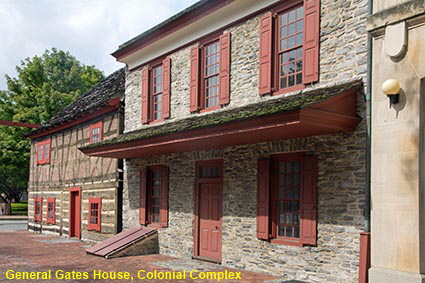
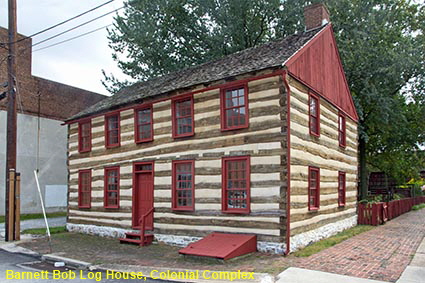
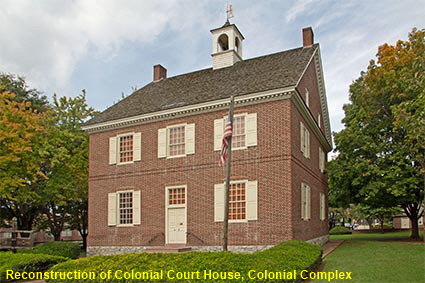
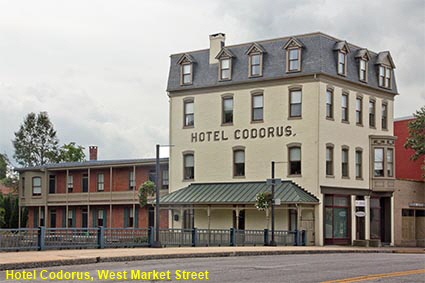
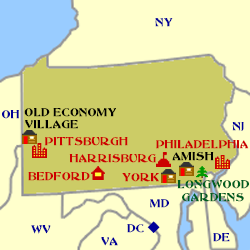

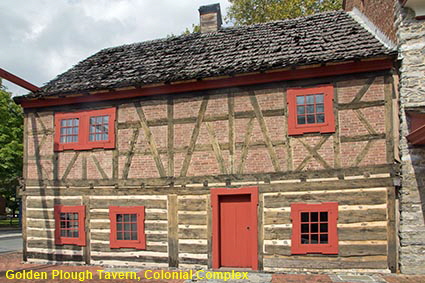
Golden Plough Tavern, Colonial Complex
The Golden Plough Tavern dates right back to 1741. It was built as a single storey family home by Martin Eichelberger. It is thought that he added the upper floor to provide family accommodation when he converted it into a tavern. The tavern has half timbered walls that were typical of German architecture of that era. In late 1777 tavern was the meeting place of the Conway Cabal who plotted to oust George Washington after the British took Philadelphia. The Tavern is open to the public Tuesday to Saturday as part of the Colonial Complex.
© Mike Elsden 1981 - 2025
The contents of this page may not be reproduced in full or in part without permission